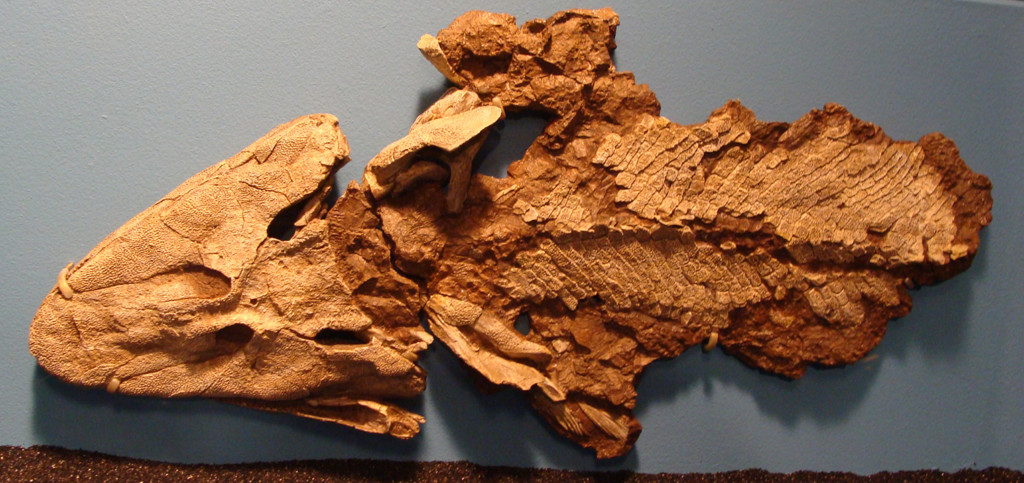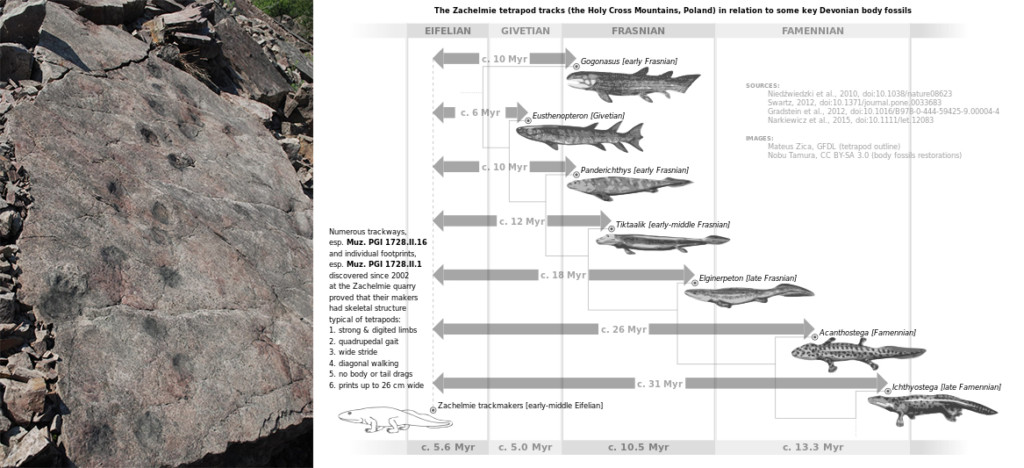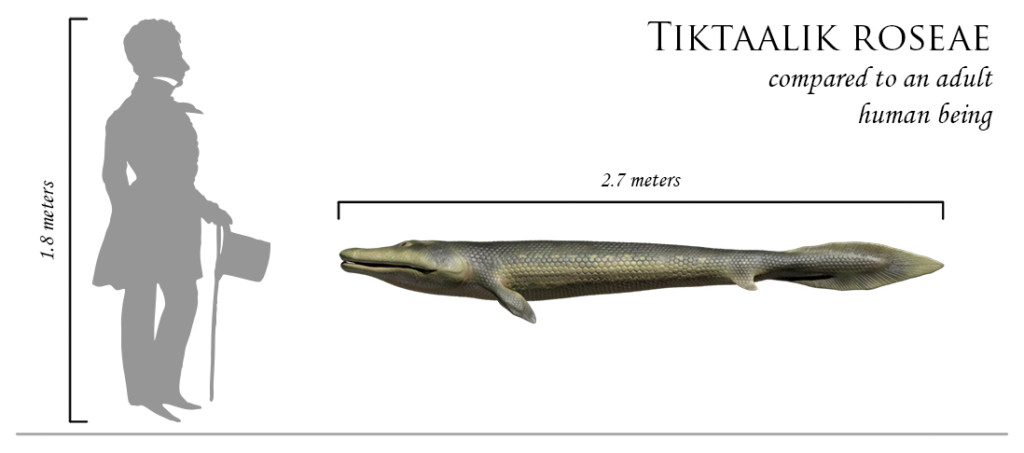
Tiktaalik – “Darwin’s Fish” At Last?
It is morning.
Calm silence hangs over the fringes of an antediluvian coal swamp. Thin curtains of fog rise from the stagnant waters as the first beams of sunlight trickle in over the tops of the forest beyond. There, the swamp becomes an impenetrable jungle of fronds and massive, tree-like lycopods. Here, it is but a vast, waterlogged expanse of knotted, tendril-like vegetation.
It is the wet season, and rising water levels have caused these transitional zones to flood, creating a network of shallow pools. One of these pools plays host to a shoal of tiny, baby fish. Easy prey for the large predators that share their habitat, these fish will remain here, in the safety of the shallows, until they are big enough to venture forth and fend for themselves.
The calm of the nursery is soon shattered as a dark shape slithers past. Panicked, the young fish scatter – too late. With a twist of its neck and a snap of its broad, flat jaws, the intruder effortlessly gobbles a mouthful of the tiny fingerlings before returning to the comfort of deeper water.
This is Tiktaalik, a two-meter-long carnivorous fish. Perfectly designed to hunt in shallow water, it is a scourge upon the baby fish, but an important subject for the student of origins.
The Discovery
The first skeletons of Tiktaalik were discovered in 2004 by paleontologists Edward Daeschler, Neil Shubin, and Farish Jenkins, Jr while on a fossil finding expedition on Ellesmere Island in Northern Canada.

One of the three Tiktaalik fossils discovered on Ellesmere Island. Image source
The fossils were found when a team member spotted one of the animals’ snouts sticking out of a cliffside. After excavating, the team managed to recover three nearly complete and well-preserved specimens – an excellent find indeed!
It was not, however, until after the specimens had been cleaned up in the lab that the real excitement began.
Although Tiktaalik was definitely a fish, possessing gills and fin rays, it had other traits that seemed more appropriate for a land animal1).
Among these traits were:
- A flattened skull, more similar to a crocodile or amphibian than the typical fish.
- A mobile neck that, unlike other fish, allowed Tiktaalik to move its head independently from the pectoral girdle.
- Spiracles on top of the head, as well as both internal and external nostrils, suggesting some air-breathing ability.
- Robust pectoral fins with complex “wrist” joints that (it was supposed) might have allowed Tiktaalik to support itself on land.
With these and other traits in mind, it seemed that the paleontologists had stumbled across a verifiable transitional form – a “missing link” that bridged the gap between fish and early tetrapods!
The Hype
Media response to the find was predictably strong, and, while the general excitement over the fossils and their significance to Darwinian science was expected, it was curious to see how often the coverage would turn towards mocking biblical creationists.
One particularly salty New York Times article2) spent almost a quarter of its length hammering on the many ways that these fossils were “a powerful rebuttal to religious creationists, who have long argued that the absence of such transitional creatures are a serious weakness in Darwin’s theory.”
Illustrators and paleoartists continued the charge, satirizing the ignorance of “religious extremists” through political cartoons, while cementing the idea of Tiktaalik as the “walking fish” by depicting it as booking along the shoreline on suspiciously limb-like fins.

Left: A political cartoon mocking a 2005 decision by the Kansas Board of Education that allowed students to be taught the weaknesses of Darwinian evolution (source unknown). Right: A bizarrely well-developed Tiktaalik shown crawling on land. Image source
A True “Missing Link?”
Although it would be wrong to say that Tiktaalik gave nothing for evolutionists to excite themselves over, claims that it was some kind of hybrid land/sea dwelling “fishpod” creature are gross exaggerations.
The fins of Tiktaalik, for instance, while dexterous and robust, were not anchored to the rest of the main skeleton3), meaning that, contrary to popular opinion, they would have been incapable of supporting the creature on land. It is far more likely that these fins were used to propel Tiktaalik along the bottom of its watery home, allowing it to safely push its way through areas that would be too shallow for other, similarly-sized fish.
The flat head and mobile neck, while also very amphibian-like, would have been necessary to accommodate Tiktaalik’s shallow water lifestyle, allowing it to snatch at fast-moving prey without having to pull its entire body around.
Even the presence of nostrils and the ability to breathe air are not unheard of among fish. Many modern species, including the gar, the lungfish, and the ever-popular betta are capable of breathing air to some degree (although the exact method varies between groups), a trait that enables them to thrive in shallow or oxygen-poor environments.

Left: A longnose gar (Image source), Center: An Australian lungfish (Image source), Right: A pair of emerald betta (Image source)
The true blow to Tiktaalik’s transitional status, however, occurred in 2010, when a series of fossilized footprints were found in Poland4). According to evolutionary dating methods, these footprints were about 397 million years old – 12 million years older than Tiktaalik’s given age!

Left: Tetrapod tracks found in Poland in 2010 predated Tiktaalik and other “transitional” fish by millions of years. Image source, Right: This chart shows the fossil ages of various tetrapod ancestors relative to the age of the Polish footprint-maker (the amphibian at the bottom left). Image source
It is common sense that one cannot be younger than one’s own child. As such, there is no way that Tiktaalik could have been the evolutionary grandfather of tetrapods if tetrapods already existed.
But wait, there’s more.
As stated above, the Polish trackway is dated at 397 million years old. However, Eusthenopteron, the oldest of the “transitional” fish, dates as only 385 million years old – 12 million years younger! Even the chart above, which gives a generously early date for Eusthenopteron, shows it as 6 million years too late.
In other words, not only do these footprints disqualify Tiktaalik as a tetrapod ancestor, they disqualify the whole fish-tetrapod sequence entirely! Such temporal paradoxes are surprisingly common in evolutionary paleontology, yet almost never gain the attention they deserve.
Johnathan Sarfati comments:
“This [referring to the fish-tetrapod sequence mixup] is yet another parallel with alleged bird evolution—undoubted beaked birds like Confuciusornis are 10 Ma older than their alleged feathered dinosaur ‘ancestors’. Evolutionists would argue that it is not a problem, for the same reason that sometimes a grandfather can outlive his grandson. This is correct, but one of the major ‘evidences’ of evolution is how the evolutionary order supposedly matches the fossil sequence. So the mismatch of claimed order of appearance with claimed phylogeny undermines the evolutionary explanation.”5)
Evolutionists try to explain away temporal paradoxes by implying that the later forms existed previously, but simply didn’t fossilize until later on. While technically possible, this renders the order of the fossils useless as an evidence for Evolution. If the fossils can simply be moved around when inconvenient, then the fossil sequence becomes arbitrary and irrelevant.
Creation scientists, of course, have no problem explaining such “out-of-place” fossils. According to current models, it is believed that most of the fossil record was formed as a result of Noah’s Flood burying different ecosystems in sequence. Therefore, the “age” of Tiktaalik and other creatures within the fossil record has far less to do with when they lived than where they lived.
Tetrapods may have been rare in Tiktaalik’s neck of the woods, but, having lived at the same time and only a little farther inland, there is no reason that one could not have left footprints below it in the rock record.
Conclusion
It is easy to give the issue of transitional forms more weight than it demands.
In the case of Tiktaalik, we have a fish that, while quite at home in the water, bears certain traits that are more characteristic of land animals. These bizarre features are not inherently proof of Evolution, but are simply facts for Evolution to explain.
According to the Evolutionist, these traits existed because environmental conditions were causing Tiktaalik to evolve from a fish-like ancestor into a tetrapod descendant. The creation scientist, however, can just as easily claim that the traits existed because God intelligently designed Tiktaalik to take advantage of habitats that straddled the line between water and land.
Both explanations, within their respective worldviews, are logically valid and, therefore, the proofs cancel each other out. The real battle is over the meaning of the fossil record in general.
If the fossil record, as Darwinism teaches, formed over hundreds of millions of years, recording the evolution of life on Earth as it did so, then transitional sequences are just that – transitional. If, however, the biblical model is correct and the fossils were mostly formed during the year of Noah’s Flood, then even the most perfect transitional form or sequence becomes irrelevant.
After all, how can creatures “transition” into each other if they all lived at the same time?
As Christians, we must remind ourselves that our battle is not one of fossils and artifacts, but of worldviews and the implications they bring. When we become well-versed in these deeper, foundational subjects, individual surface elements, like “walking fish,” become less threatening. Sure, they may be odd, even unexpected, but, so long as one’s worldview is founded on truth, there will always be a reasonable explanation just around the corner.
References
| ↑1 | Daeschler, Edward B., Neil H. Shubin, and Farish A. Jenkins. “A Devonian tetrapod-like fish and the evolution of the tetrapod body plan.” Nature 440, no. 7085 (2006): 757-63. doi:10.1038/nature04639. |
|---|---|
| ↑2 | Wilford, John Noble. “Fossil Called Missing Link From Sea to Land Animals.” The New York Times. April 05, 2006. Accessed October 07, 2017. http://www.nytimes.com/2006/04/06/science/06fossil.html. |
| ↑3 | Sarfati, Jonathan. “Tiktaalik—a fishy ‘missing link’.” Journal of Creation 21, no. 1 (2007): 53-57. |
| ↑4 | Niedzwiedzki, Grzegorz, Piotr Szrek, Katarzyna Narkiewicz, Marek Narkiewicz, and Per E. Ahlberg. “Tetrapod trackways from the early Middle Devonian period of Poland.” Nature 463 (January 7, 2010): 43-48. |
| ↑5 | Sarfati, 56. |

